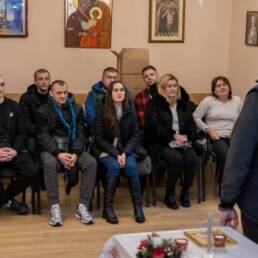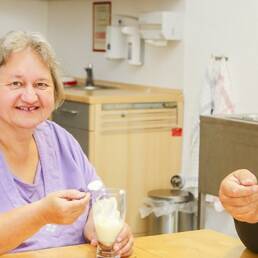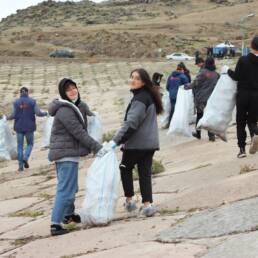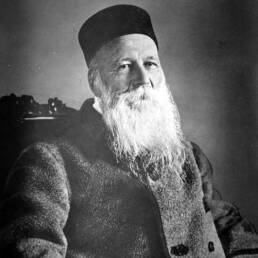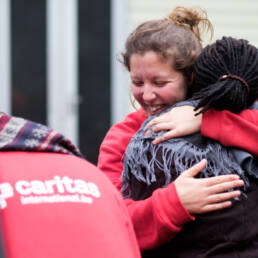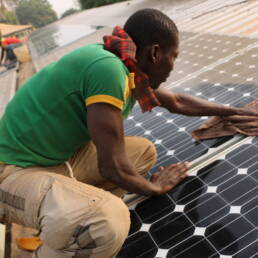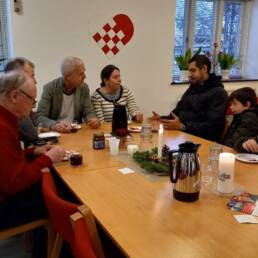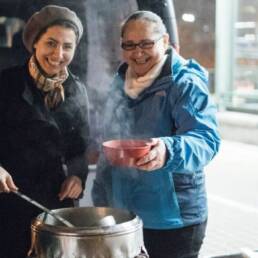Let us look for the meaning of shared bread
The World Day of the Poor was established by Pope Francis. In this year’s message, Pope Francis encourages us to fulfil the words of Prophet Isaiah telling believers how to conduct themselves. They are “to loose the bonds of wickedness, to undo the thongs of the yoke, to let the oppressed go free and to break every yoke… to share bread with the hungry and bring the homeless and poor into the house… to cover the naked” (Isa 58:6-7). According to the Pope, it is also a way to avoid keeping distance from the poor and to be like Jesus, who does not reject the poor, but instead he invites them to himself and comforts them. We adopt such attitude when we break bread with the poor.
During the World Day of the Poor, let us turn towards an essential element of our reality, namely bread. It is because bread is the most basic food in our culture. However, we do not use it in everyday life only. We bring bread to the altar as a gift, along with wine, and it becomes the Body of Christ during the Liturgy of the Eucharist. Bread and wine were the thanksgiving offering to God in the Old Testament. Also, bread and wine were chosen by Christ to become His Body and Blood.
Now, let us think how to understand this gesture of sharing bread with the needy.
Where should we look for bread?
When we visit the Holy Land, we can come across meaningful traces of evangelical events. There is Tabgha at the foot of the Mount of Beatitudes. The name is probably an Arabic mispronunciation of the Greek Heptapegon, meaning “seven springs.” The local hot springs were already known in the ancient times. Their water reaches over 30 centigrade and has healing properties because of sulphur. The area is usually associated with a miracle of Jesus when he multiplied bread and fed a huge crowd of people as well as with the primacy of St. Peter.
There is the Church of the Multiplication in Tabgha. The name refers to a passage from the Gospel when Jesus took five loaves and two fish, said a blessing, and gave them to the disciples to feed the people (Mark 6:32-44). A specific illustration of this miracle can be found under the main altar of the Tabgha church. It is an elaborate floor mosaic which depicts a basket with four loaves and two fish. Everyone can notice a discrepancy between the mosaic and the Gospel. We immediately ask what happened to the fifth loaf. We can interpret the artist’s depiction from a theological point of view. The mosaic placed in front of the altar suggests that the fifth loaf of bread is represented by the Host brought by believers to the altar during the Eucharist.
On the one hand, the Sacramental bread is a gift of God. On the other hand, it is the fruit of work of human hands. Bread is not just a mere mixture of ingredients such as flour and water, but it is the result of human thought, cooperation of various people, and common work of many: it needs, after all, not only sowers, farmers, harvesters, millers, bakers, and merchants, but also those who buy it. As a result, bread becomes a symbol of unity.
In the Didache, an ancient treatise, we can find a prayer to God: “As this broken bread was scattered upon the mountains, but was brought together and became one, so let thy Church be gathered together from the ends of the earth into thy kingdom.” (9:4) Moreover, bread becomes eschatological food from a theological perspective. As St. John the Evangelist writes meaningfully: “Whoever eats this bread will live forever.” (John 6:51)
Who should get the multiplied bread?
In his Gospel, St. Mark includes two stories about the multiplication of bread. The first story tells about feeding five thousand people (Mark 6:32-44) and it is a sign for Jews. The other one describes feeding of four thousand people (Mark 8:1-10), which should be perceived as a sign for pagans. The first event took place in the land of Israel, whereas the second one was out of it. We can tell that the goals of both miracles were different merely by analysing the words used to describe baskets and broken pieces left over. In the first story, we have a word kofinos which refers to a basket Jews used to carry food. It is connected with twelve basketfuls of broken pieces of bread picked up by the disciples. The number refers to the twelve generations of Israel. In the second story, the word for basket is spyris. It is the name known to pagans. It is juxtaposed to seven baskets of the broken pieces left over. The number seven usually represents the world in the Bible. In both cases, the aforementioned redactional traits seem to emphasise the same thought. It is stated here that Jesus’ bread is for everyone, and in abundance, as this abundance is shown in the broken pieces left over by the crowd.
We should also have a look at a blessing Jesus said in the first story. It was a blessing Jews usually said before the meal. While being among pagans, Jesus followed the Greek tradition with the thanksgiving. Moreover, we can again scrutinise the number of people fed. Four thousand pagan listeners may symbolise the four corners of the world, and thus all people in the world. As for five loaves and five thousand Jews, we can refer them to the Torah, also known as the Pentateuch. It is the most important part of the Hebrew Scriptures where we can read about God raining down bread from heaven for the Israelites on their way to the Promised Land. Hence, we can conclude that God’s work continued in Jesus. The manna sent in the wilderness of Sinai saved the Israelites and it was written in the Pentateuch. The bread multiplied in a solitary place was the beginning of all the gifts of Jesus and we can read about it in the Gospel.
To sum up, we should emphasise that the first multiplication of bread was a sign of the Son of God from the family of David who first worked among the chosen nation. The second multiplication took place among pagans and it showed that the Church would bring Christ’s salvation to the whole world. However, in both cases we can see something unusual. In order to feed the needy, the Saviour had to make use of human hands that would produce even a small amount of good. When we offer something good in the name of Jesus Christ, we can save others. It is similar in the Eucharist and between people in their communities: Christ responds to human needs by sending other people to them.
Bread of mercy
We should add some words from the Apocalypse: “Here I am! I stand at the door and knock. If anyone hears my voice and opens the door, I will come in and eat with that person, and they with me.” (Rev 3:20) Once again, these words show that a man is called for an intimate relationship with the Creator. This intimacy between God and man is emphasised by His invitation to the Eucharist (and to the eternal feast in heaven as well). The feast is constantly prepared by God Himself. He is the Host who breaks bread for His guest and gives him His gifts. However, it does not mean that we feast with God on our own. We need to share with other children of God, namely our brothers and sisters. When we repent to have our sins forgiven and are ready to forgive others, we receive a true communion from the Eucharist, which is unity with both, God and other people. By communion with the Host, even strangers become close to each other when they meet around the gifts and share with each other.
The unity which we receive in the Eucharist makes us go out into the streets of our cities, towns, and villages to share bread with others. Giving bread to the needy, we follow Jesus and can multiply God’s gifts. That way we retrieve a loaf of bread, which is like the fifth loaf symbolically added to the mosaic of Tabgha. It is the Sacramental bread. This bread gives us strength to look for gifts in our own reserves and to share them with others. May the meeting at the altar and the World Day of the Poor spent in the Caritas family make us more open to those who have too little bread. May everyone get some bread of mercy!


